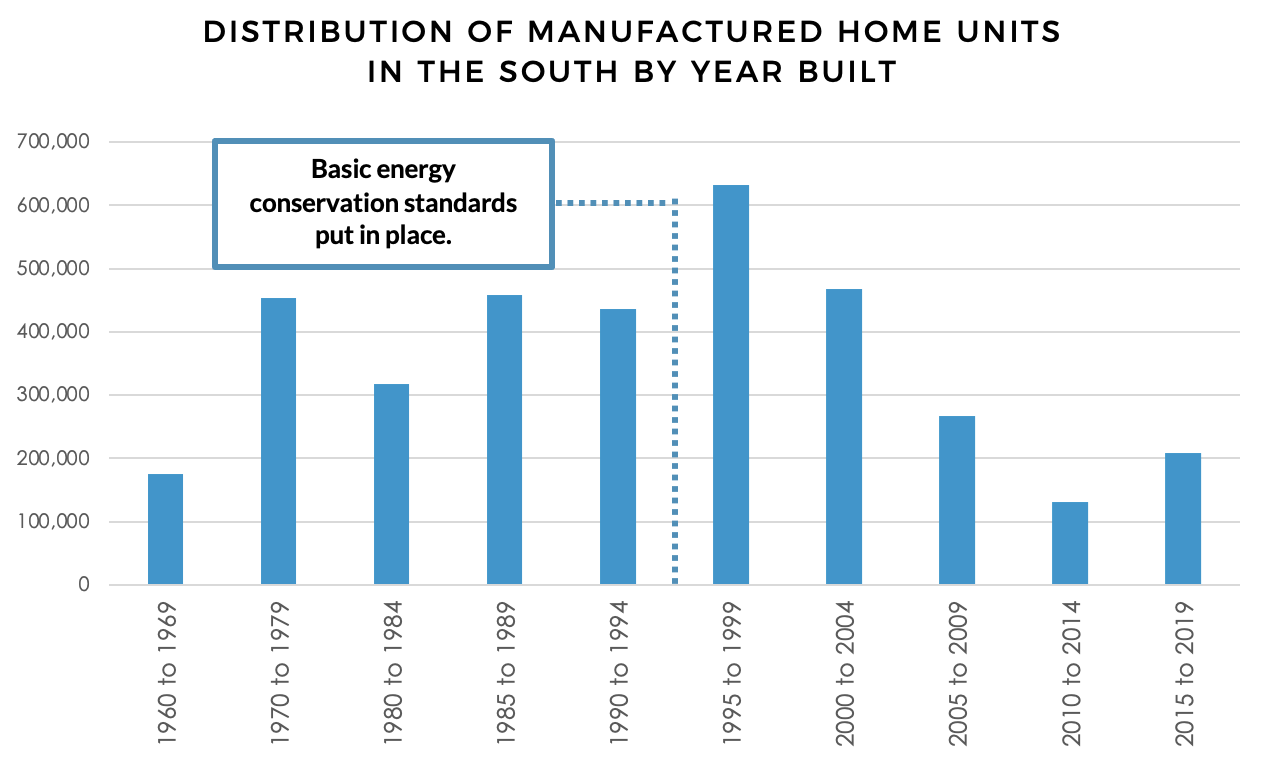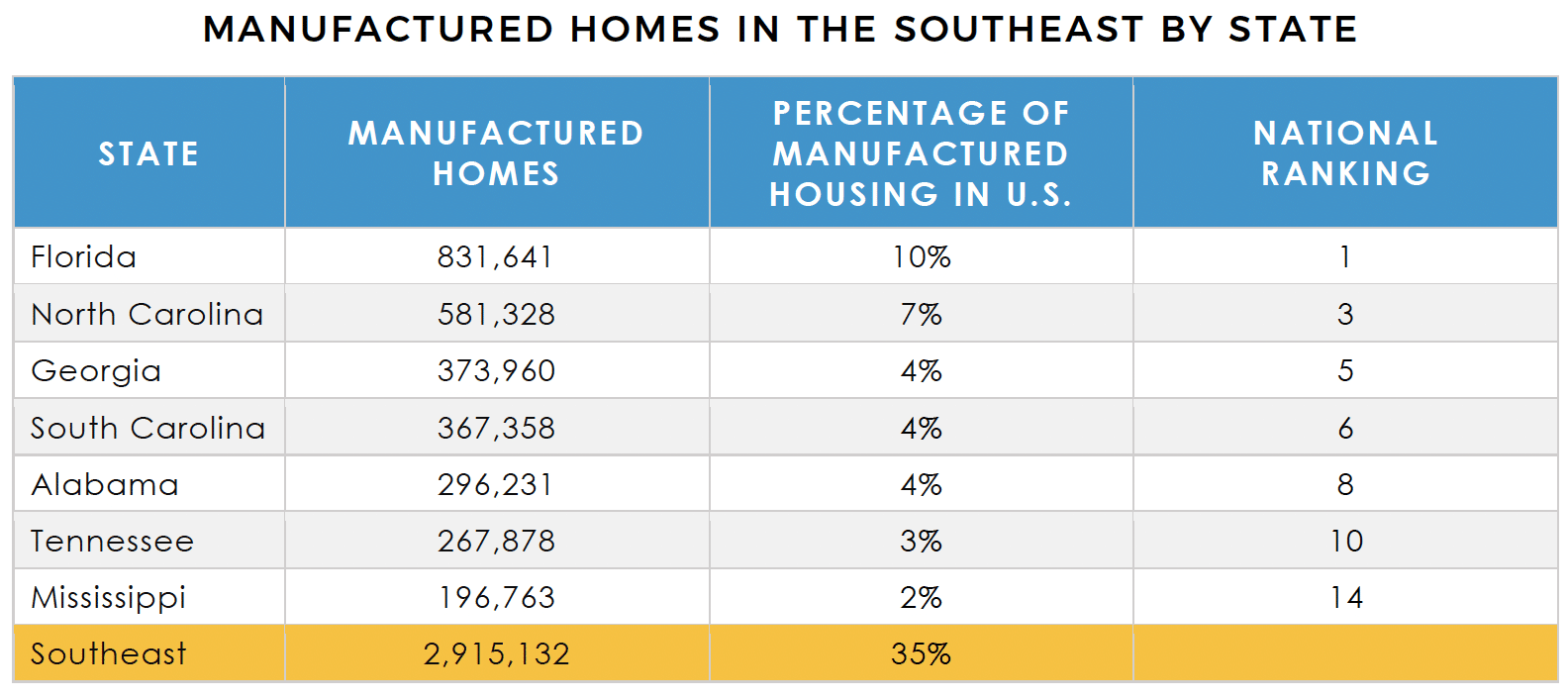Manufactured homes consume far more energy per square foot than other types of construction, making electric bills unaffordable for many residents. Despite the South having more manufactured homes than any other region, its utilities have historically failed to meet the needs of this housing segment. But advocacy efforts are gaining traction as we push for expanded program offerings across the region.
Forest Bradley-Wright | April 19, 2023 | Energy Efficiency, Florida, Georgia, UtilitiesEach year the Southern Alliance for Clean Energy compiles efficiency performance data from nearly 500 electric utilities in the Southeast, comparing them based on annual efficiency savings as a percentage of total utility electric sales. The most recent data and analysis for 2021 are presented here in our fifth annual “Energy Efficiency in the Southeast” report.
This blog post, the third in our series, examines the need for energy efficiency programs for the millions of underserved families living in manufactured homes across the Southeast.

Watch the Webinar Read the Report Read the Report Blog Series
The Southeast has the highest concentration of manufactured homes in the country. Of the 8.4 million manufactured homes in the U.S., 2.9 million are in the Southeast (about 35% of the national total). Since the United States is in the middle of an affordable housing crisis, in many places manufactured homes are filling the gap. But until recently Southeastern utilities have failed to adequately serve the unique energy efficiency needs of families in manufactured homes.
 Manufactured housing, also known as mobile homes, are a type of house that is built in a factory. Due to manufactured homes’ different materials and construction techniques, they have the highest energy consumption per square foot of any housing type, using over 50% more electricity per square foot on average than single- or multi-family homes. Moreover, the majority of manufactured homes are occupied by low- and fixed-income households, with average incomes that are far lower than single-family homes. So efficiency improvements in manufactured homes have the potential to deliver deep reductions in energy waste while providing much-needed financial benefits for residents.
Manufactured housing, also known as mobile homes, are a type of house that is built in a factory. Due to manufactured homes’ different materials and construction techniques, they have the highest energy consumption per square foot of any housing type, using over 50% more electricity per square foot on average than single- or multi-family homes. Moreover, the majority of manufactured homes are occupied by low- and fixed-income households, with average incomes that are far lower than single-family homes. So efficiency improvements in manufactured homes have the potential to deliver deep reductions in energy waste while providing much-needed financial benefits for residents.
Federal Energy Standards are Lower for Manufactured Homes
In 1976, the Department of Housing and Urban Development (HUD) established a set of uniform construction and safety standards for manufactured homes known as HUD Code. HUD Code helped ensure the durability and longevity of manufactured homes, but its energy-related provisions were underwhelming and did not meaningfully address high energy usage. Unfortunately, this important set of standards is not updated regularly or even frequently. In fact, it wasn’t until 1994 that major changes were made to the HUD code that significantly improved the requirements for energy efficiency in manufactured homes. Thus, the generation of HUD homes built from 1976-1994 are relatively long-lasting, but extremely inefficient compared to modern standards. The majority of manufactured homes in the South fall in this category.

For the first time in nearly 30 years, the energy standards for manufactured homes were updated in 2022, but the new requirements still lag behind those designed for single-family site-built homes. Moreover, many changes in the new energy standards for manufactured homes apply only to double-wide units, not single-wide units – which represent about 45% of all new manufactured homes delivered nationally. For instance, single-wide homes can still be produced with single-pane windows and very little insulation. And of course, there are still millions of existing manufactured homes currently in use with high energy consumption that the new standards won’t impact.
This creates a gap to be filled by utility energy efficiency retrofit programs, both to fix major efficiency deficiencies in the existing stock of manufactured homes and to improve the efficiency performance of new manufactured homes, as well.
A Turning Point for Manufactured Homes Efficiency Programs
Acting on SACE’s recommendation in its 2022 Integrated Resource Plan (IRP) proceeding, the Georgia Public Service Commission (PSC) recently directed Georgia Power to set aside $1.5 million over the next three years specifically for efficiency projects in manufactured homes. The program will retrofit existing manufactured homes with energy efficiency improvements as part of the broader Home Energy Improvement Program. Each year the utility will separately identify spending and savings for manufactured homes participating in its efficiency program. Georgia Power representatives have noted that the program is expected to be very cost-effective, producing between $1.60 – $1.80 in energy savings for each program dollar spent. Not only will this program bring needed financial benefits to manufactured housing residents, but the program also reduces the utility’s total cost of supplying power to all customers.
This is important progress for Georgia, which has the fifth-highest total of manufactured homes in the country. Nevertheless, there is still more opportunity going forward. The Commission’s 2022 approval of the manufactured homes retrofit program was a big step in the right direction, but the Commission did not act on a second component of SACE’s manufactured homes program recommendation, which would have provided incentives for the purchase of highly efficient new manufactured homes and the replacement of units that cannot reasonably be improved through retrofits. Such programs have been successfully deployed in other jurisdictions, thereby addressing an important need that will otherwise go unmet. Because utility resource planning happens every three years in Georgia, the new and replacement manufactured homes program may well be considered again as part of the next Georgia Power Integrated Resource Plan (IRP) proceedings in 2025.
Enormous Underserved Need for Efficiency in Manufactured Homes
Nearly every state in the Southeast ranks in the top ten nationally for the total number of manufactured homes, which make up more than 11% of all housing in the region. But the housing segment has been historically overlooked and underserved by utility energy efficiency programs. For instance, although North Carolina is the overall energy efficiency leader in the Southeast, it does not have any energy efficiency programs specifically designed for the unique needs of its nearly half a million manufactured homes (third highest in the country). Florida has more manufactured homes than any other state (10% of the national total) but is one of the lowest-performing states in the country for utility energy efficiency. Utilities in Florida offer no efficiency programs designed for manufactured homes.

Expanding Manufactured Homes Focus Across the Southeast
It’s time for every state in the Southeast to prioritize energy efficiency programs for manufactured homes. In addition to Georgia’s recent leadership on energy efficiency for manufactured homes, Entergy Arkansas and the Tennessee Valley Authority (TVA) have also operated successful programs, which could also serve as models for other utilities to follow. Unfortunately, despite prior success, TVA has eliminated nearly all of its energy efficiency program offerings in recent years, including the one for manufactured homes.
On the other hand, Mississippi Power recently announced that it would be following its sister company Georgia Power by offering a new manufactured housing efficiency retrofit program. In 2021 Mississippi Power filed a plan with its Public Service Commission indicating that it intended to roughly double its overall efficiency savings levels over the next seven years to 0.5% of its 2020 retail sales. To achieve those levels, the utility has already added several new programs, including for multifamily and manufactured housing.
In 2020, SACE and our advocacy partners negotiated a settlement agreement with Duke Energy in North Carolina that led to working together to co-design a new low-income pilot program. While not explicitly a manufactured housing efficiency program, the Residential Income Qualified High Energy Use Pilot Program, approved by the North Carolina Utilities Commission this February, aims to serve customers with high energy usage, including manufactured homes.
Our work to expand energy efficiency services to manufactured housing residents continues across the Southeast. Stay tuned for further developments as they occur, and additional blog posts on other energy efficiency topics from across the Southeast.
Watch the Webinar Read the Report Read the Report Blog Series
#EEReport2023